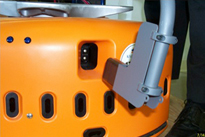Power & Signal Rover Interconnect
CHALLENGE
 Methode was asked to design a connector for charging a robot battery that integrates power and signal contacts, with low mating force that can be blind-mated without human intervention. The connector is also designed to survive over 3,000 charge cycles and still maintain connection integrity.
Methode was asked to design a connector for charging a robot battery that integrates power and signal contacts, with low mating force that can be blind-mated without human intervention. The connector is also designed to survive over 3,000 charge cycles and still maintain connection integrity.
SOLUTION
Methode designed a custom connector, using WovenBud™ high-current contacts, that has a large physical compliance range.
STORY
This application is for a mobile roaming unit (robot) powered by batteries that retrieves product in a warehouse. When the robot senses that its batteries need recharging, it automotically locates an available charging station, aligns and mates with the charging connector.
The connector design for this operation is a variation of existing connectors, featuring two power contacts for the charging circuit, and several signal contacts to sense hookup and control switching operation. The key advantage of the WovenBud technology was the very low insertion force needed to mate the connector so that very little force impact transferred against the mobile unit. Additionally, the contacts have a high cycle life of 3,000 plus cycles and can handle charging currents while keeping the package relatively small.
Product design-specific features and benefits include:
- Blind-mate capable and low-insertion force
- Support gross application alignment
- Increase cycle life to 3,000 plus cycles
- Friendly mating conditions
- Custom package form
- Integrated signal contacts
- Optimum mating stroke
